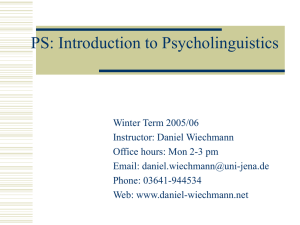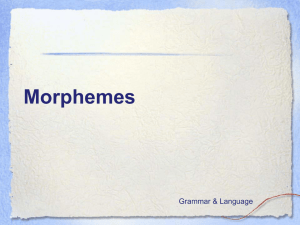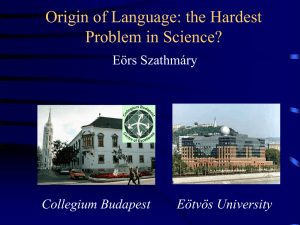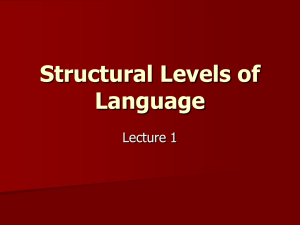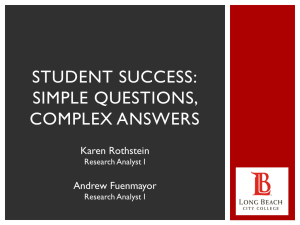ENGLISH SYNTAX
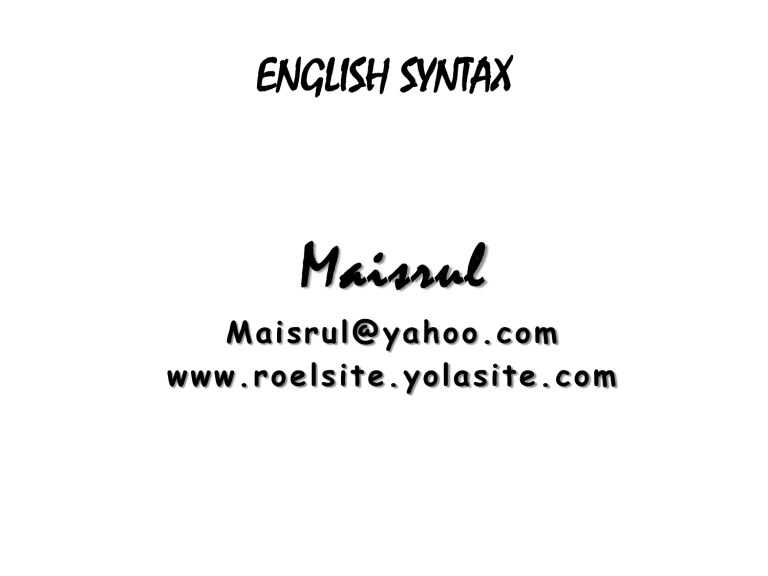
ENGLISH SYNTAX
Maisrul
Maisrul@yahoo.com
www.roelsite.yolasite.com
ENGLISH SYNTAX
•
• Linguistics is scientific study of language
• Language is a system of arbitrary vocal symbols used for human communication.
• As a system language has two system
- System of Sound
- System of Meaning
Where is the position of Syntax?
FORM,
MEANING,
FUNCTION
LANGUAGE
UNITS
LANGUAGE
SCIENCE
INTERDICIPLINARY VIEW
SEMANTICS
SYNTAX
FORM/
LOGICAL
MEANING
MORPHOLOGY LINGUISTICS
FORM
PHONOLOGY
ENGLISH SYNTAX
Linguistic Unit and the Sentence
• Syntactic descriptions have traditionally taken the sentence as their starting point and the smaller units being primarily regarded as ‘building-blocks’ of sentences.
• Sentence consits of string of words, in sequence, and meaningful.
• Sentences are interpreted not as strings of individual words but as sequence of groups of words and between them exist certain relations called sentence structure e.g word order.
* He wanted to marry Jane. * He wanted jane to marry .
ENGLISH SYNTAX
Constituents
• The parts into which a sentence can be segmented are the constituents of the sentence.
• Immediate Constituents (IC) refers to those constituents which together form a higherorder constituent.
– Jane wants a cake a and cake are the IC’s of a cake wants and a cake are the I.C’s of wants a cake
Jane and wants a cake are the IC of the sentence
ENGLISH SYNTAX
Rankscale and Rankshift
• Rankscale is the hierarchy of units of linguistic description in which morphemes function as constituents of words, words function as constituent of phrases, and phrases as constituent of sentences.
We’ve made some minor corrections
Sentence some minor corrections
Phrase
Corrections
Word
Correct-ion-s
Morpheme
ENGLISH SYNTAX
Rankscale and Rankshift
• Rankshift : unit of given rank functions as a constituent of a unit of the same rank or even lower down the rankscale, e.g. Sentences function as constituent of other sentences, phrase to other phrases, word to other words, etc.
1. I know Peter is in the army
2. At the corner of the street
3. Treetop - gorldsmith - Blackbird
setentence
phrase
word
ENGLISH SYNTAX
Functions and Categories
• There is a distinction between linguistic units as constituents of larger structures and as linguistics objects in their own right; i.e Function and Category.
Function refers to a linguistic unit viewed as an element that plays its role in a larger linguistic structure.
Category refers to a linguistic unit viewed as something that has individual charateristics which it shares with other units of the same kind
ENGLISH SYNTAX
Functions and Categories
John took a walk
The unit of John and a walk viewed individually are
Noun; so they belong to the same category or word class
The unit of John and a walk viewed as constituents of the sentence, both John and a walk belong to different function. John function as Subject and a walk function as Object
ENGLISH SYNTAX
Morpheme
Morpheme
The minimal unit of gramatical description in the sense that it cannot be segmented any further at the grammatical level of analysis .
There are two kinds of Morpheme; Free and bound .
Free Morpheme can be used independently, whereas Bound Morpheme can not.
Morpheme
Unfriendly
1 . U n
2 . F r i e n d
3 . L y r o o t b a s e
( o f u n f r i e n d l y ) b o u n d f r e e b o u n d f r i e n d f r i e n d l y
Morpheme
Root of a word is that part which remains when all the affixes have been removed.
A Base is any form to which an affix can be added, but not every base is a root.
Impression
Impress
Press base root
Morpheme
• Allomorphs is the variants within a morpheme.
Plural morpheme h a t - / s/, d og- /z /, b u s- / i z/, d eer - / o /
– /s/, /z/, /iz/, / o /
– / o / allomorph
Zero allomorph
The plural
The plural morpheme {S1} is regularly realized in three ways:
/s/ : after basis ending in voiceless sounds except sibilants, eg: books, roofs, lips, hats,
/z/ : after bases ending in voiced sounds except sibilants, eg: trees, bars, laws, zoos, days, boys, ribs, beds, dogs, flames, pens, bootless
/iz/ : after bases ending in a sibilant:
/s/
/z/
/ʃ/
/t /
/dз/
: horses, nurses, kisses
: noises, seizes, noses
: brushes, dishes, clashes
: churches, torches, witches
: pledges, bridges, languages
The genitive
In the singular the genitive morpheme {S2} is regularly realized in three ways:
/s/ :after bases ending in voiceless sounds except sibilants, eg:
Dick
Ship
-Dick’s car
-the ship’s crew
Dentist -the dentist’s drill
Wife -his wife’s lover
/z/ :after bases ending in voiced sounds except sibilants, eg:
Fred -Fred’s salary
Play -the play’s title
Brother -my brother’s cottage
Firm -the firm’s losses
/iz/ :after bases ending in a sibilant, eg:
Horse -horse’s tail
Keats -Keats’s poetry
George -George’s children
ENGLISH SYNTAX
Five Signal of
Syntactic Structure
Five Signal of Syntactic Structure
1. Word order
Position of words relative to each other
2. Prosody
Combinations of Pattern of pitch, stress, and juncture.
3. Function words
Words with little or no lexical meaning which are used in combining other words into larger structures.
Five Signal of Syntactic Structure
4. Inflections
Suffixes, always final, which adapt words to fit varying structural positions without changing their lexical meaning or part of speech.
5. Derivational Contrast
Derivational prefixes and suffixes which change words from one part of speech to another.
Eight Main Groups of Function Words
1. Noun Determiners the, a/an, my, her, their…,that/this one, two…,some, all, many, few, other, more……
2. Auxiliaries can, may, could, will, would, shall, should, need, do, be, have, be going to….
Eight Main Groups of Function Words
3. Qualifiers
Very, quite, rather, a little, so, more, most, less, enough, too, …
4. Preposition
- simple: after, around, before, …
- Compound: back of, due to, together with..
- Phrasal: by means of, in front of, on account of,…
Eight Main Groups of Function Words
5. Coordinators and, not, but, nor, rather than, either, …
6. Interrogators
- simple: when, where, how, why
- Interrogative Pronoun: who, what, which, whoever, whatever
Eight Main Groups of Function Words
7. Includers
- Simple: after, although, how, since,…
- Relative Pronoun: who, which, that, when, etc
8. Sentence-linkers
- Simple: consequently, furthermore, hence
- Phrasal: at least, in addition, in fact, etc
ENGLISH SYNTAX
FOUR TYPES OF SYNTACTIC
STRUCTURE
FOUR TYPES OF SYNTACTIC
STRUCTURE
• Structures of Modification
– Consist of two immediate constituents a head and a modifier.
Hungry people
M H
Home town
M H
Easily superior
M H
FOUR TYPES OF SYNTACTIC
STRUCTURE
• Structures of Predication
– Consist of two immediate constituents a subject and a predicate.
The sun sets in the west
The snow was cold
FOUR TYPES OF SYNTACTIC
STRUCTURE
• Structures of Complementation
– Consist of two immediate constituents a verbal elements and a complement we are learning grammar
He gives a lesson
He caught and ate the fish
FOUR TYPES OF SYNTACTIC
STRUCTURE
• Structures of Coordination
– Consist of two or more immediate constituents which are equavalent units joined in a structure which function as a single unit.
He bought his friend a doctor and a gentlemen

